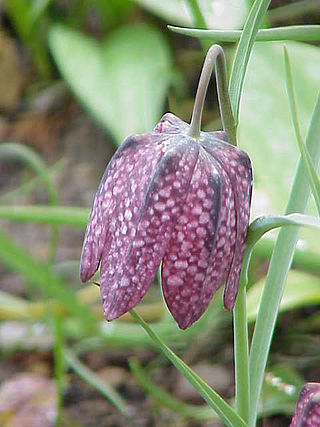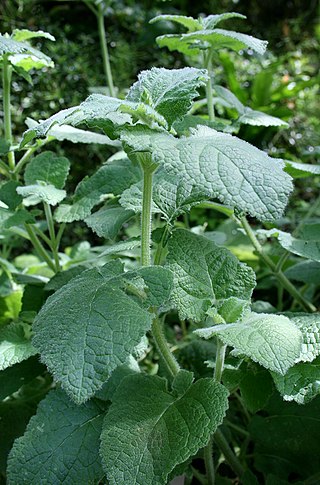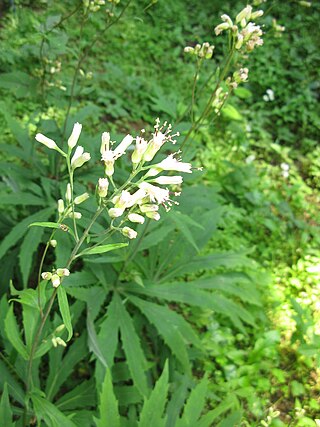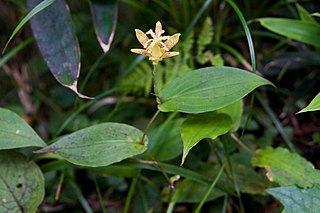
Fritillaria (fritillaries) is a genus of spring flowering herbaceous bulbous perennial plants in the lily family (Liliaceae). The type species, Fritillaria meleagris, was first described in Europe in 1571, while other species from the Middle East and Asia were also introduced to Europe at that time. The genus has about 130–140 species divided among eight subgenera. The flowers are usually solitary, nodding and bell-shaped with bulbs that have fleshy scales, resembling those of lilies. They are known for their large genome size and genetically are very closely related to lilies. They are native to the temperate regions of the Northern hemisphere, from the Mediterranean and North Africa through Eurasia and southwest Asia to western North America. Many are endangered due to enthusiastic picking.

Carl Johann Maximovich was a Russian botanist. Maximovich spent most of his life studying the flora of the countries he had visited in the Far East, and naming many new species. He worked at the Saint Petersburg Botanical Gardens from 1852 as curator of the herbarium collection, becoming Director in 1869.

Fritillaria camschatcensis is a species of flowering plant native to northeastern Asia and northwestern North America, including northern Oregon, Washington, British Columbia, Alaska, northern Japan, and the Russian Far East. It has many common names, including Kamchatka fritillary and Kamchatka lily.
Maximowicz's vole is a species of rodent in the family Cricetidae. It is found in northeastern China, Mongolia, and eastern Russia.

Fritillaria verticillata is a flowering plant in the lily family Liliaceae, native to Japan, Korea, Mongolia, Xinjiang, Kazakhstan and the Altay region of Siberia.

Fritillaria pallidiflora is an Asian species of bulbous flowering plant in the lily family Liliaceae, native to Xinjiang, Kyrgyzstan and Kazakhstan. The common name frequently used is Siberian fritillary, a misnomer because the species does not grow in the wild in Siberia.

Juglans mandshurica, also known as Monkey nuts, or Tigernut, is a deciduous tree of the genus Juglans, native to the Eastern Asiatic Region. It grows to about 25 m.

Lycoris squamigera, the resurrection lily or surprise lily, is a plant in the amaryllis family, Amaryllidaceae, subfamily Amaryllidoideae. It is also sometimes referred to as naked ladies. It is native to SE China and Korea

Prunus campanulata is a species of cherry native to Japan, Taiwan, southern and eastern China, and Vietnam. It is a large shrub or small tree, growing 3–8 m (10–26 ft) tall. It is widely grown as an ornamental tree, and a symbol of Nago in the Ryukyu Islands of Japan. It is variously known in English as the Taiwan cherry, Formosan cherry, or bellflower cherry. It was described in 1883 by Carl Johann Maximowicz.

Salvia przewalskii is a herbaceous perennial plant native to the Chinese provinces of Gansu, Hubei, Sichuan, Xizang, and Yunnan, typically growing along stream banks, forest edges, among shrubs, and on granitic hillsides. It was described and named in 1881 by the Russian botanist Carl Maximowicz after the Russian explorer and botanist Nikolai Przhevalsky, who made several collecting trips to China in the 19th century. The plant is widely known throughout its native habitat for its medicinal properties.

Syneilesis is a genus of East Asian plants in the groundsel tribe within the Asteraceae.
Nannoglottis is a genus of Asian flowering plants in the family Asteraceae.
Symphyllocarpus is a genus of flowering plants in the family Asteraceae. The genus is poorly known, and botanists have not reached a consensus as to its evolutionary relations.

Chionographis is a genus of plants in the Melanthiaceae first described as a genus in 1867. This genus is native to China, Japan, and Korea.

Tricyrtis latifolia, the toad lily, is an East Asian species of plants in the lily family.
Allium maackii is a species of wild onion native to northeastern Asia. It is found on cliff and steep hillsides at elevations of 200–500 m.

Allium sacculiferum, also called northern plain chive or triangular chive, is an East Asian species of wild onion native to Japan, Korea, eastern Russia, and northeastern China. It is found along the banks of lakes and rivers at elevations less than 500 m.
Fritillaria cirrhosa, common name yellow Himalayan fritillary, is an Asian species of herbaceous plant in the lily family, native to China, the Indian Subcontinent, and Myanmar.

Fritillaria ussuriensis is a species of flowering plant in the lily family Liliaceae, native to Korea, the Primorye Region of Russia, and northeastern China.

Acer barbinerve, commonly known as bearded maple, is an Asian species of maple found in Korea, eastern Russia, and northeastern China.














